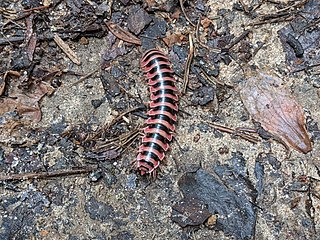
Polydesmida is the largest order of millipedes, with more than 5,000 species, including all the millipedes reported to produce hydrogen cyanide (HCN). This order is also the most diverse of the millipede orders in terms of morphology. Millipedes in this order are found in all regions of the world other than Antarctica.

Xystodesmidae is a family of millipedes in the suborder Leptodesmidea within the order Polydesmida. The family Xystodesmidae was created by the American biologist Orator F. Cook in 1895 and named after the genus Xystodesmus. This family includes more than 390 known species distributed among 62 genera. Many species, however, remain undescribed: for example, it is estimated that the genus Nannaria contains over 200 species, but only 25 were described as of 2006. By 2022, 78 species in Nannaria have been described.

Motyxia is a genus of cyanide-producing millipedes that are endemic to the southern Sierra Nevada, Tehachapi, and Santa Monica mountain ranges of California. Motyxias are blind and produce the poison cyanide, like all members of the Polydesmida. All species have the ability to glow brightly: some of the few known instances of bioluminescence in millipedes.

Pseudopolydesmus is a genus of flat-backed millipedes in the family Polydesmidae.

Pleuroloma flavipes, commonly known as the traveling cherry millipede, is a species of flat-backed millipede in the family Xystodesmidae. It has the widest distribution of any species of xystodesmid millipede and is found in eastern North America from southeastern North Dakota, eastward to Connecticut, and southward to North Carolina, northern Louisiana, and southern Texas. Pleuroloma flavipes millipedes are occasionally observed in large aggregations of individuals where they appear to move en masse in a certain direction, hence the common name "wandering cherry millipede". In a report from 1950, an aggregation of about 6,000 individuals were encountered on a single bridge at McCormick's Creek State Park, Indiana. The species is extremely variable in coloration, and converges in appearance with several species of Apheloria and Brachoria as a result of mimicry.

Striariidae is a family of millipedes in the order Chordeumatida. Adult millipedes in this family have 30 segments. There are at least 3 genera and about 13 described species in Striariidae.

Semionellus is a genus of flat-backed millipedes in the family Xystodesmidae. There are at least three described species in Semionellus.
Chonaphini is a tribe of flat-backed millipedes in the family Xystodesmidae. There are about 6 genera and 19 described species in Chonaphini.

Thrinaxoria is a genus of flat-backed millipedes in the family Xystodesmidae. There are at least three described species in Thrinaxoria.

Boraria is a genus of flat-backed millipedes in the family Xystodesmidae. There are about seven described species in Boraria.

Sigmoria is a genus of flat-backed millipedes in the family Xystodesmidae. There are more than 40 described species in Sigmoria.
Aniulus is a genus of millipedes in the family Parajulidae. There are more than 20 described species in Aniulus.

Cherokia Chamberlin, 1949 is a genus consisting of a single species, Cherokia georgiana. Commonly known as the wrinkled flat-backed millipede, this species belongs to the order Polydesmida and the family Xystodesmidae. It inhabits forests in the southeastern United States, particularly those with hemlock, maple, tulip poplar, rhododendron, cedar, and spruce-fir trees.

Eurymerodesmus is a genus of flat-backed millipedes in the family Eurymerodesmidae. There are more than 30 described species in Eurymerodesmus.

Abacion is a genus of crested millipedes in the family Abacionidae. There are about 10 described species in Abacion.
Auturus is a genus of flat-backed millipedes in the family Euryuridae. There are about 11 described species in Auturus.

Rudiloria is a genus of millipedes in the family Xystodesmidae, found in eastern North America.

Nannaria swiftae, also known as the Swift twisted-claw millipede or Taylor Swift's millipede, is a species of millipede in the family Xystodesmidae. It is found only in the Appalachian mountains of the U.S. state of Tennessee. It was discovered and described in 2022 by entomologists Derek Hennen, Jackson Means and Paul Marek, who expanded the genus Nannaria to 78 species. They named the species in honor of American singer-songwriter Taylor Swift.
Devillea is a genus of flat-backed millipedes in the family Xystodesmidae. These millipedes are rare and limited to caves. Species in this genus are found in Sardinia, Capri, and southern France in the Maritime Alps. These species are notable for featuring more than the 20 segments usually found in the order Polydesmida. This genus is one of only two genera in this order to feature these extra segments and the first such genus to be discovered.














